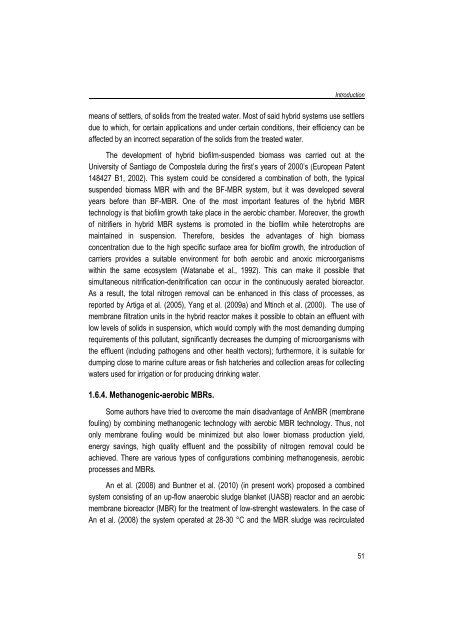Combining submerged membrane technology with anaerobic and ...
Combining submerged membrane technology with anaerobic and ...
Combining submerged membrane technology with anaerobic and ...
You also want an ePaper? Increase the reach of your titles
YUMPU automatically turns print PDFs into web optimized ePapers that Google loves.
Introductionmeans of settlers, of solids from the treated water. Most of said hybrid systems use settlersdue to which, for certain applications <strong>and</strong> under certain conditions, their efficiency can beaffected by an incorrect separation of the solids from the treated water.The development of hybrid biofilm-suspended biomass was carried out at theUniversity of Santiago de Compostela during the first’s years of 2000’s (European Patent148427 B1, 2002). This system could be considered a combination of both, the typicalsuspended biomass MBR <strong>with</strong> <strong>and</strong> the BF-MBR system, but it was developed severalyears before than BF-MBR. One of the most important features of the hybrid MBR<strong>technology</strong> is that biofilm growth take place in the aerobic chamber. Moreover, the growthof nitrifiers in hybrid MBR systems is promoted in the biofilm while heterotrophs aremaintained in suspension. Therefore, besides the advantages of high biomassconcentration due to the high specific surface area for biofilm growth, the introduction ofcarriers provides a suitable environment for both aerobic <strong>and</strong> anoxic microorganisms<strong>with</strong>in the same ecosystem (Watanabe et al., 1992). This can make it possible thatsimultaneous nitrification-denitrification can occur in the continuously aerated bioreactor.As a result, the total nitrogen removal can be enhanced in this class of processes, asreported by Artiga et al. (2005), Yang et al. (2009a) <strong>and</strong> Mtinch et al. (2000). The use of<strong>membrane</strong> filtration units in the hybrid reactor makes it possible to obtain an effluent <strong>with</strong>low levels of solids in suspension, which would comply <strong>with</strong> the most dem<strong>and</strong>ing dumpingrequirements of this pollutant, significantly decreases the dumping of microorganisms <strong>with</strong>the effluent (including pathogens <strong>and</strong> other health vectors); furthermore, it is suitable fordumping close to marine culture areas or fish hatcheries <strong>and</strong> collection areas for collectingwaters used for irrigation or for producing drinking water.1.6.4. Methanogenic-aerobic MBRs.Some authors have tried to overcome the main disadvantage of AnMBR (<strong>membrane</strong>fouling) by combining methanogenic <strong>technology</strong> <strong>with</strong> aerobic MBR <strong>technology</strong>. Thus, notonly <strong>membrane</strong> fouling would be minimized but also lower biomass production yield,energy savings, high quality effluent <strong>and</strong> the possibility of nitrogen removal could beachieved. There are various types of configurations combining methanogenesis, aerobicprocesses <strong>and</strong> MBRs.An et al. (2008) <strong>and</strong> Buntner et al. (2010) (in present work) proposed a combinedsystem consisting of an up-flow <strong>anaerobic</strong> sludge blanket (UASB) reactor <strong>and</strong> an aerobic<strong>membrane</strong> bioreactor (MBR) for the treatment of low-strenght wastewaters. In the case ofAn et al. (2008) the system operated at 28-30 °C <strong>and</strong> the MBR sludge was recirculated51
















